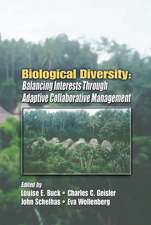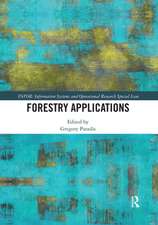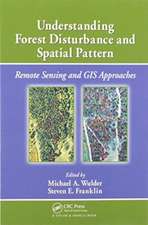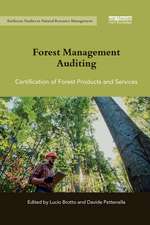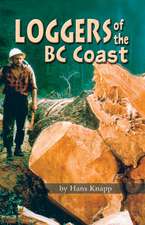Managing Biological and Ecological Systems: Environmental Management Handbook, Second Edition, Six-Volume Set
Editat de Brian D. Fath, Sven Erik Jorgensenen Limba Engleză Hardback – 30 iul 2020
The experience, evidence, methods, and models used in studying environmental management are presented here in six stand-alone volumes, arranged along the major environmental systems.
Features
- The first handbook that demonstrates the key processes and provisions for enhancing environmental management
- Addresses new and cutting-edge topics on ecosystem services, resilience, sustainability, food–energy–water nexus, socio-ecological systems, and more
- Provides an excellent basic knowledge on environmental systems, explains how these systems function, and offers strategies on how to best manage them
- Includes the most important problems and solutions facing environmental management today
| Toate formatele și edițiile | Preț | Express |
|---|---|---|
| Paperback (1) | 436.19 lei 6-8 săpt. | |
| CRC Press – 14 feb 2022 | 436.19 lei 6-8 săpt. | |
| Hardback (1) | 995.39 lei 6-8 săpt. | |
| CRC Press – 30 iul 2020 | 995.39 lei 6-8 săpt. |
Preț: 995.39 lei
Preț vechi: 1333.86 lei
-25% Nou
Puncte Express: 1493
Preț estimativ în valută:
190.47€ • 207.54$ • 160.50£
190.47€ • 207.54$ • 160.50£
Carte tipărită la comandă
Livrare economică 23 aprilie-07 mai
Preluare comenzi: 021 569.72.76
Specificații
ISBN-13: 9781138342644
ISBN-10: 1138342645
Pagini: 444
Ilustrații: 45 Tables, black and white; 44 Illustrations, black and white
Dimensiuni: 178 x 254 x 30 mm
Greutate: 0.93 kg
Ediția:2 New edition
Editura: CRC Press
Colecția CRC Press
Seria Environmental Management Handbook, Second Edition, Six-Volume Set
ISBN-10: 1138342645
Pagini: 444
Ilustrații: 45 Tables, black and white; 44 Illustrations, black and white
Dimensiuni: 178 x 254 x 30 mm
Greutate: 0.93 kg
Ediția:2 New edition
Editura: CRC Press
Colecția CRC Press
Seria Environmental Management Handbook, Second Edition, Six-Volume Set
Cuprins
Section I: APC: Anthropogenic Chemicals: The Articles Cover Human-Manufactured Chemicals and Activities 1. Animals: Sterility from Pesticides 2. Bacillus thuringiensis: Transgenic Crops 3. Biopesticides 4. Birds: Chemical Control 5. Birds: Pesticide Use Impacts 6. Insect Growth Regulators Section II: COV: Indicates That the Articles Give Comparative Overviews of Important Topics for Environmental Management 7. Biodiversity and Sustainability 8. Biofertilizers 9. Ecosystems: Large-Scale Restoration Governance 10. Ecosystems: Planning and Trade-offs 11. Natural Enemies: Conservation 12. Pests: Landscape Patterns Section III: CSS: The Articles Gives a Case Study of a Particular Environmental Management Example 13. Biological Control of Vertebrates: Myxoma Virus and Rabbit Hemorrhagic Disease Virus as Biological Controls for Rabbits 14. Cabbage Disease Ecology and Management 15. Natural Enemies and Biocontrol: Artificial Diets Section IV: DIA: Means That the Articles Are about Diagnostic Tools: Monitoring, Ecological Modeling, Ecological Indicators, and Ecological Services 16. Animals: Toxicological Evaluation 17. Bioindicators for Sustainable Agroecosystems 18. Ecological Indicators: Eco-Exergy to Emergy Flow 19. Ecological Indicators: Ecosystem Health 20. Sustainable Fisheries: Models and Management Section V: ENT: Addresses Environmental Management Using Environmental Technologies 21. Bioremediation: Contaminated Soil Restoration 22. Biotechnology: Pest Management 23. Plant Pathogens (Fungi): Biological Control 24. Plant Pathogens (Viruses): Biological Control 25. Stored-Product Pests: Biological Control 26. Weeds (Insects and Mites): Biological Control Section VI: NEC: Natural Elements and Chemicals: The Articles Cover Basic Elements and Chemicals Found in Nature 27. Antagonistic Plants 28. Arthropod Host-Plant Resistant Crops 29. Biomass 30. Nematodes: Biological Control Section VII: PRO: The Articles Cover Basic Environmental Processes 31. Agroforestry: Water Use Efficiency 32. Bacterial Pest Control 33. Bioaccumulation 34. Biodegradation 35. Biological Control of Vertebrates 36. Biological Controls 37. Biological Factors Impeding Recovery of Predatory Fish Populations 38. Bioremediation 39. Composting 40. Insects and Mites: Biological Control 41. Invasion Biology
Notă biografică
Brian D. Fath is a Professor in the Department of Biological Sciences at Towson University (Maryland, USA) and a Senior Research Scholar at the International Institute for Applied Systems Analysis (Laxenburg, Austria). He has published over 180 research papers, reports, and book chapters on environmental systems modeling, specifically in the areas of network analysis, urban metabolism, and sustainability. He has co-authored the books A New Ecology: Systems Perspective (2020), Foundations for Sustainability: A Coherent Framework of Life–Environment Relations (2019), and Flourishing within Limits to Growth: Following Nature’s Way (2015). He is also Editor-in-Chief for the journal Ecological Modelling and Co-Editor-in-Chief for Current Research in Environmental Sustainability. Dr. Fath was the 2016 recipient of the Prigogine Medal for outstanding work in systems ecology and twice a Fulbright Distinguished Chair (Parthenope University, Naples, Italy, in 2012 and Masaryk University, Czech Republic, in 2019). In addition, he has served as Secretary General of the International Society for Ecological Modelling, Co-Chair of the Ecosystem Dynamics Focus Research Group in the Community Surface Modeling Dynamics System, and member and past Chair of the Baltimore County Commission on Environmental Quality.
Sven E. Jørgensen (1934–2016) was a Professor of Environmental Chemistry at Copenhagen University. He earned a doctorate of engineering in environmental technology and a doctorate of science in ecological modeling. He was an honorable doctor of science at Coimbra University (Portugal) and at Dar es Salaam (Tanzania). He was Editor-in-Chief of Ecological Modelling from the journal’s inception in 1975 until 2009. He was Editor-in-Chief for the Encyclopedia of Environmental Management (2013) and Encyclopedia of Ecology (2008). In 2004, Dr. Jorgensen was awarded the Stockholm Water Prize and the Prigogine Medal. He was awarded the Einstein Professorship by the Chinese Academy of Sciences in 2005. In 2007, he received the Pascal Medal and was elected a member of the European Academy of Sciences. He published over 350 papers and has edited or written over 70 books. Dr. Jorgensen gave popular and well-received lectures and courses in ecological modeling, ecosystem theory, and ecological engineering worldwide.
Sven E. Jørgensen (1934–2016) was a Professor of Environmental Chemistry at Copenhagen University. He earned a doctorate of engineering in environmental technology and a doctorate of science in ecological modeling. He was an honorable doctor of science at Coimbra University (Portugal) and at Dar es Salaam (Tanzania). He was Editor-in-Chief of Ecological Modelling from the journal’s inception in 1975 until 2009. He was Editor-in-Chief for the Encyclopedia of Environmental Management (2013) and Encyclopedia of Ecology (2008). In 2004, Dr. Jorgensen was awarded the Stockholm Water Prize and the Prigogine Medal. He was awarded the Einstein Professorship by the Chinese Academy of Sciences in 2005. In 2007, he received the Pascal Medal and was elected a member of the European Academy of Sciences. He published over 350 papers and has edited or written over 70 books. Dr. Jorgensen gave popular and well-received lectures and courses in ecological modeling, ecosystem theory, and ecological engineering worldwide.
Descriere
This volume introduces the general concepts and processes of the biosphere and its systems. It explains how these systems function and provides strategies on how to best manage them. It serves as an excellent resource for finding basic knowledge on the biosphere and includes problems and solutions that environmental managers face today.








